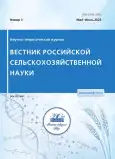Influence of planting and maintenance practices on the soil’s agrophysical properties, yield and quality of potato varieties of kamchatka breeding
- Authors: Gainatulina V.V1, Khasbiullin R.A1, Khasbiullina O.I1
-
Affiliations:
- Kamchatka Research Institute of Agriculture
- Issue: No 3 (2023)
- Pages: 32-36
- Section: Articles
- URL: https://journals.rcsi.science/2500-2082/article/view/147900
- DOI: https://doi.org/10.31857/2500-2082/2023/3/32-36
- EDN: https://elibrary.ru/OMAGZI
- ID: 147900
Cite item
Full Text
Abstract
About the authors
V. V Gainatulina
Kamchatka Research Institute of Agriculture
Email: Khasbiullina@kamniish.ru
R. A Khasbiullin
Kamchatka Research Institute of Agriculture
O. I Khasbiullina
Kamchatka Research Institute of Agriculture
References
- Башмакова О.Н., Будина Е.А. Эффективные агроприемы на картофеле в Кировской области // Картофель и овощи. 2015. № 11. С. 29-30.
- Доспехов Б.А. Методика полевого опыта: (с основами статистической обработки результатов исследований). 5-е изд., перераб. и доп. М.: Колос, 1985. 416 с.
- Зейрук В.Н., Анисимов Б.В., Деревягина М.К. и др. Система интегрированной экологически безопасной защиты картофеля от болезней, вредителей и сорняков: (Рекомендации). М., 2010. С.6-10.
- Методика исследований по культуре картофеля. М., НИИКХ, 1967. 263с.
- Методика проведения агротехнических опытов, учетов, наблюдений и анализов на картофеле / [сост. С.В. Жевора, Л.С. Федотова, В.И. Старовойтов, В.Н. Зейрук, А.В. Коршунов и др.] ФГБНУ ВНИИКХ. М., 2019. 120 с.
- Николаева А.В., Шашкаров Л.Г. Влияние агротехнических приемов на рост и развитие растений картофеля // Агроэкологические и организационно-экономические аспекты создания и эффективного функционирования экологически стабильных территорий: материалы Всероссийской научно-практической конференции, Чебоксары, 05 октября 2017 года. Чебоксары: Чувашская государственная сельскохозяйственная академия, 2017. С. 124-127. EDN ZUXPKL.
- Ряховская Н.И., Гайнатулина В.В., Власенко Г.П. и др. Система земледелия Камчатского края. ФГБНУ Камчатский НИИСХ, Петропавловск-Камчатский, 2015. 200с.
- Серегина Н.И. Сорт, качество, технология - факторы высокой урожайности картофеля // Картофель и овощи. 2012. № 6. С.7-8.
- Kahnt G. Minimal Bodenbearbeitung. Verlag Eugen Ulmer Stuttgart, 1999. 112 pp.
Supplementary files










